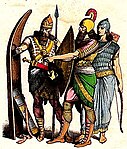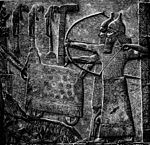This article has multiple issues. Please help improve it or discuss these issues on the talk page . (Learn how and when to remove these messages)
|
| Siege of Azekah | |||||||
|---|---|---|---|---|---|---|---|
| Part of Sennacherib's campaign in Judah | |||||||
 Azekah Inscription | |||||||
| |||||||
| Belligerents | |||||||
| Neo-Assyrian Empire | Kingdom of Judah | ||||||
| Commanders and leaders | |||||||
| Sennacherib | Unknown | ||||||
| Strength | |||||||
| Unknown | Unknown | ||||||
| Casualties and losses | |||||||
| Unknown | Heavy | ||||||
The siege of Azekah was a battle between the Neo-Assyrian Empire and the Kingdom of Judah. It preceded the Siege of Lachish, making it the first known clash between the two kingdoms during Sennacherib's campaign in Judah. The most important source for the battle is the Azekah Inscription. [1] The battle is not mentioned in the Hebrew Bible.




